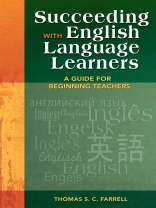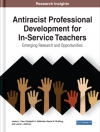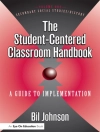‘Very relevant to the real-life teaching situations that first-year teachers often encounter.’
-Joanne Ho, English Department Chair
Clark High School, Las Vegas, NV
‘Easygoing and relaxed, a welcome break from over-flowery ′academic′ language for students ready to enter the ′real world′ of the classroom.’
-Elise Geither, Instructor
Baldwin-Wallace College
‘The ′exploratory breaks′ throughout each chapter provide readers an opportunity to apply their learning in a focused fashion.’
-Theresa Rouse, Superintendent/Principal
San Lucas Union School District, CA
Novice teachers can apply best practices for a successful ELL classroom experience!
This easy-to-navigate resource offers beginning teachers a carefully phased-in guide to teaching strategies they can use with their ESL-ELL learners to enhance reading, writing, speaking, listening, and grammar skills. Each chapter provides clear guidelines and step-by-step coverage of these essentials and more:
- Using different models for lesson planning
- Monitoring classroom behavior and interactions
- Using prepared skill-building activities or developing new ones
- Assessing students for placement in ESL or general education classes
- Reflecting and exploring the development of their own teaching practice
This sourcebook offers a solid reality-based plan for all new teachers who want to create a successful classroom experience for themselves and their ESL-EFL students!
Mục lục
Preface
Acknowledgments
About the Author
Ch 1: Teaching in the First Year
Exploratory Break 1.1: Teaching in the First Year
Exploratory Break 1.2: First Year Phases of Development
Exploratory Break 1.3: Stages of Development
Exploratory Break 1.4: Stacy′s First Years of Development
Exploratory Break 1.5: Stacy′s First Years of Support
Exploratory Break 1.6: Mentors
Exploratory Break 1.7: Teaching Load
Exploratory Break 1.8: Nature of Classes during the First Years
Exploratory Break 1.9: Helping Yourself
Chapter Reflection
Ch 2: Planning English Language Lessons
Exploratory Break 2.1: Why Plan Lessons?
Exploratory Break 2.2: Benefits of Planning Lessons
Exploratory Break 2.3: Lesson Plan Details
Exploratory Break 2.4: Writing Lesson Objectives
Exploratory Break 2.5: Lesson Design
Exploratory Break 2.6: Questions to Consider Before Lessons
Exploratory Break 2.7: Components of a Language Lesson
Exploratory Break 2.8: Questions for Teachers to Consider After the Lesson
Exploratory Break 2.9: Questions for Students to Consider After the Lesson
Chapter Reflection
Ch 3: Classroom Management
Exploratory Break 3.1: Teacher: Manager or Conductor
Exploratory Break 3.2: Organizing the Class
Exploratory Break 3.3: Conducting Group Work
Exploratory Break 3.4: Dealing with the Disengaged ESL Student
Exploratory Break 3.5: Facilitating Classroom Communication
Exploratory Break 3.6: Investigating Patterns of Interaction in Your Classroom
Exploratory Break 3.7: Facilitating Diversity
Exploratory Break 3.8: Facilitating Different Learning Styles
Exploratory Break 3.9: Looking Ahead
Chapter Reflection
Ch 4: Teaching Grammar
Exploratory Break 4.1: Teaching and Grammar
Exploratory Break 4.2: Grammar
Exploratory Break 4.3: Teaching Grammar
Exploratory Break 4.4: Inductive and Deductive Grammar Teaching
Exploratory Break 4.5: Why Is English So Hard?
Exploratory Break 4.6: Grammar Activity Using the CRISP Method
Exploratory Break 4.7: Create your own Grammar Activities Using the CRISP Method
Chapter Reflection
Ch 5: Teaching Writing
Exploratory Break 5.1: Writing
Exploratory Break 5.2: Purpose and Audience
Exploratory Break 5.3: Writing as Product
Exploratory Break 5.4: Writing as Process
Exploratory Break 5.5: Teaching Writing
Exploratory Break 5.6: Assumptions About Writing
Exploratory Break 5.7: Peer Evaluation
Exploratory Break 5.8: Peer Editing
Exploratory Break 5.9: Feedback
Exploratory Break 5.10: The Place of Grammar
Chapter Reflection
Ch 6: Teaching Speaking
Exploratory Break 6.1: Speaking a Second/Foreign Language
Exploratory Break 6.2: Rules of Face-to-Face Interaction
Exploratory Break 6.3: Turn-taking
Exploratory Break 6.4: Teaching Turn-taking
Exploratory Break 6.5: Establishing Topics
Exploratory Break 6.6: Topics
Exploratory Break 6.7: Conversation Breakdowns
Exploratory Break 6.8: Repair
Exploratory Break 6.9: Teaching Dimensions of Speaking
Exploratory Break 6.10: Accuracy versus Fluency
Exploratory Break 6.11: Guidelines for Planning Speaking Lessons
Exploratory Break 6.12: Project Focus
Exploratory Break 6.13: Project Information
Exploratory Break 6.14: Class Project
Chapter Reflection
Ch 7: Teaching Reading
Exploratory Break 7.1: Reading Habits
Exploratory Break 7.2: Reading Definition
Exploratory Break 7.3: Models of Reading
Exploratory Break 7.4: Reading Strategy Profile
Exploratory Break 7.5: Reading Strategies
Exploratory Break 7.6: Prior Knowledge
Exploratory Break 7.7: Word Association
Exploratory Break 7.8: Direct Experience
Exploratory Break 7.9: Cinquain
Exploratory Break 7.10: Prediction
Exploratory Break 7.11: Skimming
Exploratory Break 7.12: Scanning
Exploratory Break 7.13: Teaching New Vocabulary
Exploratory Break 7.14: Text Structures
Chapter Reflection
Ch 8: Teaching Listening
Exploratory Break 8.1: Listening
Exploratory Break 8.2: Bottom-up Processing
Exploratory Break 8.3: Top-Down Processing
Exploratory Break 8.4: Interactional Purposes
Exploratory Break 8.5: Transactional Purposes
Exploratory Break 8.6: Back-channelling Signals
Exploratory Break 8.7: Local, Global, and Transitional Repairs
Exploratory Break 8.8: Comprehension Checks
Exploratory Break 8.9: Soap Activities
Chapter Reflection
Ch 9: Language Assessment
Exploratory Break 9.1: Language Assessment
Exploratory Break 9.2: Reliability and Validity
Exploratory Break 9.3: Alternative Assessment
Exploratory Break 9.4: Criterion and Norm Reference Assessment
Exploratory Break 9.5: Selected-response Assessment
Exploratory Break 9.6: Multiple-choice Tests
Exploratory Break 9.7: True-false Tests
Exploratory Break 9.8: Matching Tests
Exploratory Break 9.9: Short-answer Tests
Exploratory Break 9.10: Essay Tests
Exploratory Break 9.11: Fill-in Tests
Exploratory Break 9.12: Oral Tests
Exploratory Break 9.13: Portfolios
Exploratory Break 9.14: Self/Peer Assessment
Exploratory Break 9.15: Constructing Language Tests
Exploratory Break 9.16: Create Your Own Language Test
Chapter Reflection
Ch 10: Professional Development
Exploratory Break 10.1: Professional Development Needs Assessment
Exploratory Break 10.2: Opportunities for Reflection and Development
Exploratory Break 10.3: Action Research
Exploratory Break 10.4: Critical Incidents
Exploratory Break 10.5: Teaching Journal
Exploratory Break 10.6: Classroom Observations
Exploratory Break 10.7: Teacher Group Discussion
Chapter Reflection
References
Index
Giới thiệu về tác giả
Thomas S. C. Farrell is a professor in applied linguistics at Brock University, Canada. He has been involved with ESL and applied linguistics for the past 27 years and has written extensively on topics such as reflective practice, language teacher development, and language teacher education. His recent books include Reflective Practice in Action (2004, Corwin Press), Reflecting on Classroom Communication in Asia (2004, Longman), and Professional Development for Language Teachers (2005, Cambridge University Press, coauthored with Jack Richards).












